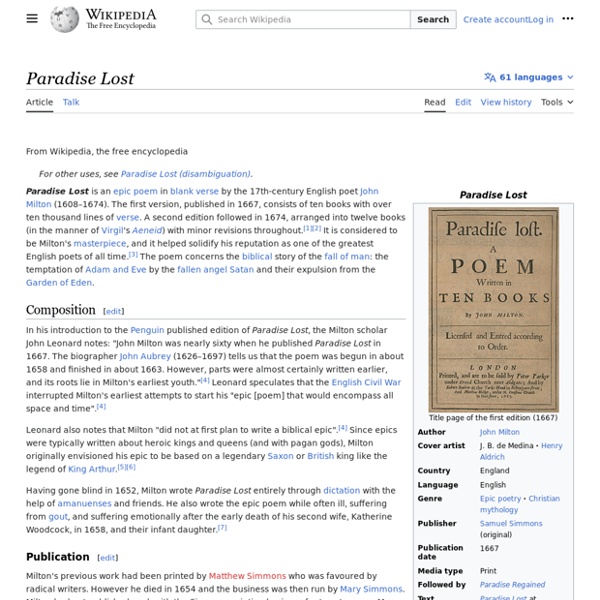Swadharma
There is no proper equivalent in English for the Sanskrit term 'Dharma'. It is generally rendered as 'duty', 'righteousness'. Any action that is best calculated to bring Sreyas (liberation) and Abhyudaya (exaltation) is Dharma.
Satire
Genre of arts and literature in the form of humor or ridicule In fiction and less frequently in non-fiction, satire is a genre of literature and performing arts, in which vices, follies, abuses and shortcomings are held up to ridicule, ideally with the intent of shaming individuals, corporations, government, or society itself into improvement. Although satire is usually meant to be humorous, its greater purpose is often constructive social criticism, using wit to draw attention to both particular and wider issues in society. Satire is nowadays found in many artistic forms of expression, including internet memes, literature, plays, commentary, television shows, and media such as lyrics. Etymology and roots[edit]
What Is Swadharma?
Sri Sri Ravi Shankar: Yes, go ahead. Who are you? Good Question to ask yourself. Who were you in your past life? That is a secret, I will tell you some other time.
Christoph Martin Wieland
1805 portrait of Christoph Martin Wieland by Ferdinand Carl Christian Jagemann Biography[edit] He was born in Oberholzheim (now part of Achstetten), which then belonged to the Free Imperial City of Biberach an der Riss in the south-east of the modern-day state of Baden-Württemberg.[citation needed] During the summer of 1750, he fell in love with a cousin, Sophie Gutermann, and this love affair inspired him to plan his first ambitious work, Die Natur der Dinge (The Nature of Things, 1752), a didactic poem in six books. In 1750 he went to the University of Tübingen as a student of law, but his time was mainly taken up with literary studies.
Svadharma
Citation styles Encyclopedia.com gives you the ability to cite reference entries and articles according to common styles from the Modern Language Association (MLA), The Chicago Manual of Style, and the American Psychological Association (APA). Within the “Cite this article” tool, pick a style to see how all available information looks when formatted according to that style. Then, copy and paste the text into your bibliography or works cited list.
Émile Benveniste
Émile Benveniste (French: [bɛ̃venist]; 27 May 1902 – 3 October 1976) was a French structural linguist and semiotician. He is best known for his work on Indo-European languages and his critical reformulation of the linguistic paradigm established by Ferdinand de Saussure. Biography[edit] Benveniste was born in Aleppo, Aleppo Vilayet, Ottoman Syria to a Sephardi family. His father sent him to Marseilles to undertake rabbinical studies, but his exceptional abilities were noted by Sylvain Lévi who introduced him to Antoine Meillet. Initially studying under Meillet, a former student of Saussure, at the Sorbonne, he began teaching at the École Pratique des Hautes Études and was elected to the Collège de France a decade later in 1937 as professor of linguistics.
Audiences will be immersed in the drama of Quantum's catered affair, 'Tamara'
If you ever wanted to follow actors around while watching a juicy drama unfold, here’s your chance to be a human camera. At Quantum Theatre’s production of “Tamara,” which opens Thursday, choose a character whose story intrigues you and follow him or her from room to room, where you can sit or stand just a few feet away from the action. ‘Tamara’ Where: Quantum Theatre at Rodef Shalom Congregation, 4905 Fifth Ave., Shadyside. Enter through the Devonshire Street doors. When: Sundays and Tuesdays at 6:30 p.m.; Wednesday, Thursday and Saturday performances start at 7 p.m.
Shramana, Śramaṇa: 4 definitions
Shramana means something in Buddhism, Pali, Hinduism, Sanskrit, Jainism, Prakrit. If you want to know the exact meaning, history, etymology or English translation of this term then check out the descriptions on this page. Add your comment or reference to a book if you want to contribute to this summary article. Purāṇa
Saudade
Saudade was once described as "the love that remains" after someone is gone. Saudade is the recollection of feelings, experiences, places, or events that once brought excitement, pleasure, well-being, which now triggers the senses and makes one live again. It can be described as an emptiness, like someone (e.g., one's children, parents, sibling, grandparents, friends, pets) or something (e.g., places, things one used to do in childhood, or other activities performed in the past) that should be there in a particular moment is missing, and the individual feels this absence. It brings sad and happy feelings together: sadness for missing and happiness for experiencing the past. Nascimento and Meandro (2005)[4] cite Duarte Nunes Leão's definition of saudade: "Memory of something with a desire for it." In Brazil, the day of Saudade is officially celebrated on 30 January.[5][6]
Shramana Movement - General Knowledge Today
3 Shares Share The Shramana movement was a Non-Vedic movement parallel to Vedic Hinduism in ancient India. The Shramana tradition gave rise to Jainism, Buddhism, and Yoga, and was responsible for the related concepts of saṃsāra (the cycle of birth and death) and moksha (liberation from that cycle). Sramanism, emphasizing thought, hard work and discipline, was one of the three strands of Hindu philosophy. The other two included Brahmanism, which drew its philosophical essence from Mimamsa.




Alliteration (h sound) and consonance (d and g sounds) together: 'Heaven openD wiDe / Her ever-During Gates, Harmonious sound / On GolDen Hinges of movinG...' (65) by morgangh Feb 21